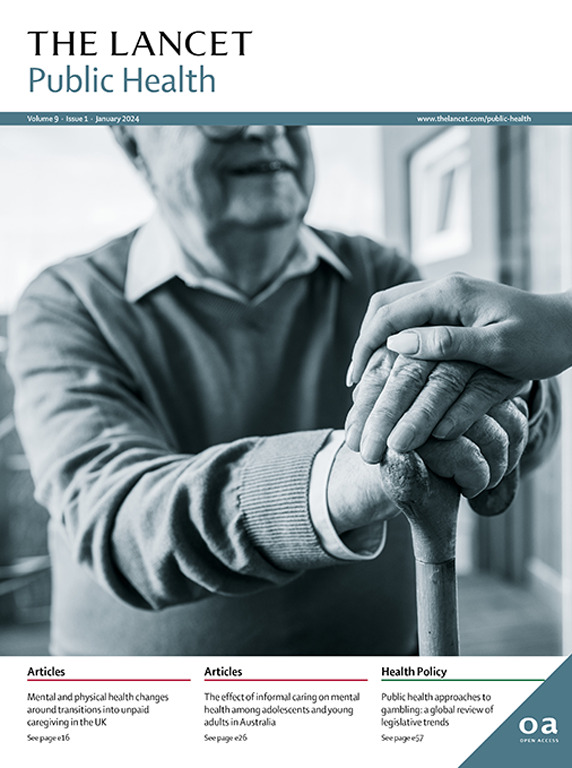Overall and late mortality among 24 459 survivors of adolescent and young adult cancer in Alberta, Canada: a population-based cohort study
IF 25.4
1区 医学
Q1 PUBLIC, ENVIRONMENTAL & OCCUPATIONAL HEALTH
引用次数: 0
Abstract
Background
Adolescent and young adult (AYA) cancer survivors are at an increased risk of premature mortality due to their cancer and its treatment. Herein, we aimed to quantify the excess risks of mortality among AYA cancer survivors and identify target populations for intervention.Methods
The Alberta AYA Cancer Survivor Study is a retrospective, population-based cohort of individuals diagnosed with a first primary neoplasm at age 15–39 years in Alberta, Canada, between 1983 and 2017. We assessed cancer survivors (ie, all individuals included in the cohort) overall and for 2-year and 5-year survivorship subpopulations. We calculated standardised mortality ratios and absolute excess risks (AERs; per 10 000 person-years) compared with the general population, and cumulative mortality probability. Causes of death were categorised as deaths due to recurrence or progression (of the first primary neoplasm), deaths due to a subsequent primary neoplasm (SPN), and deaths due to non-neoplastic causes.Findings
Among the 24 459 individuals included in the cohort, 5916 deaths were observed, which was 11·4 times (95% CI 11·1–11·7) that expected for the general population, equating to 191·6 (186·2–196·9) excess deaths; correspondingly, 5-year survivors had 4·2 times (4·0–4·4) more deaths than expected, equating to 74·3 (69·8–78·8) excess deaths. Increased age at diagnosis, poorer neighbourhood income quintile at diagnosis, first primary neoplasm type, and initial treatment plan were identified as important risk factors for mortality. While recurrence or progression was the main cause of excess mortality (AER 172·2 [167·4–177·1]), the majority of deaths beyond 10 years from diagnosis were due to SPNs and non-neoplastic causes among survivors of endometrial cancer, testicular cancer, and Hodgkin lymphoma. The cumulative mortality probability significantly decreased among more recently diagnosed survivors for all-cause mortality (p<0·0001) as well as recurrence or progression deaths (p<0·0001) and SPN deaths (p=0·0070), suggesting that long-term survival is improving.Interpretation
AYA cancer survivors have substantial excess mortality. Given the high burden of late SPN and non-neoplastic deaths, survivors of endometrial cancer, testicular cancer, and Hodgkin lymphoma are notable populations that might benefit from primary, secondary, and tertiary prevention strategies.Funding
None.加拿大艾伯塔省24459名青少年和青年癌症幸存者的总体死亡率和晚期死亡率:一项基于人群的队列研究
背景:青少年和年轻成人(AYA)癌症幸存者因其癌症及其治疗而过早死亡的风险增加。在此,我们旨在量化AYA癌症幸存者的超额死亡风险,并确定干预的目标人群。方法艾伯塔省AYA癌症幸存者研究是一项回顾性的、基于人群的队列研究,研究对象是1983年至2017年加拿大艾伯塔省15-39岁被诊断为原发性肿瘤的个体。我们评估了整体癌症幸存者(即包括在队列中的所有个体)以及2年和5年幸存者亚群。我们计算了标准化死亡率和绝对超额风险(AERs;每1万人年)与一般人群比较,以及累积死亡概率。死亡原因分为复发或进展(第一个原发肿瘤)导致的死亡、继发原发肿瘤(SPN)导致的死亡和非肿瘤原因导致的死亡。在纳入队列的24459例个体中,观察到5916例死亡,是一般人群预期的11.4倍(95% CI 11.1 - 11.7),相当于超额死亡191例(18.6 - 19.9);相应地,5年幸存者的死亡人数是预期的4.2倍(4.0 - 4.4),相当于74.3(68.9 - 78.8)例死亡。诊断时年龄增加、诊断时社区收入较低、首次原发性肿瘤类型和初始治疗计划被确定为死亡率的重要危险因素。虽然复发或进展是导致超额死亡率的主要原因(AER为172 . 2[167 . 4-177 . 1]),但在子宫内膜癌、睾丸癌和霍奇金淋巴瘤的幸存者中,诊断后10年以上的死亡主要是由于spn和非肿瘤原因。在最近诊断的幸存者中,全因死亡率(p< 0.0001)、复发或进展性死亡(p< 0.0001)和SPN死亡(p= 0.0070)的累积死亡率显著降低,表明长期生存率正在改善。癌症幸存者有相当高的死亡率。考虑到晚期SPN和非肿瘤性死亡的高负担,子宫内膜癌、睾丸癌和霍奇金淋巴瘤的幸存者是可能受益于一级、二级和三级预防策略的显著人群。
本文章由计算机程序翻译,如有差异,请以英文原文为准。
求助全文
约1分钟内获得全文
求助全文
来源期刊

Lancet Public Health
Medicine-Public Health, Environmental and Occupational Health
CiteScore
55.60
自引率
0.80%
发文量
305
审稿时长
8 weeks
期刊介绍:
The Lancet Public Health is committed to tackling the most pressing issues across all aspects of public health. We have a strong commitment to using science to improve health equity and social justice. In line with the values and vision of The Lancet, we take a broad and inclusive approach to public health and are interested in interdisciplinary research.
We publish a range of content types that can advance public health policies and outcomes. These include Articles, Review, Comment, and Correspondence. Learn more about the types of papers we publish.
 求助内容:
求助内容: 应助结果提醒方式:
应助结果提醒方式:


